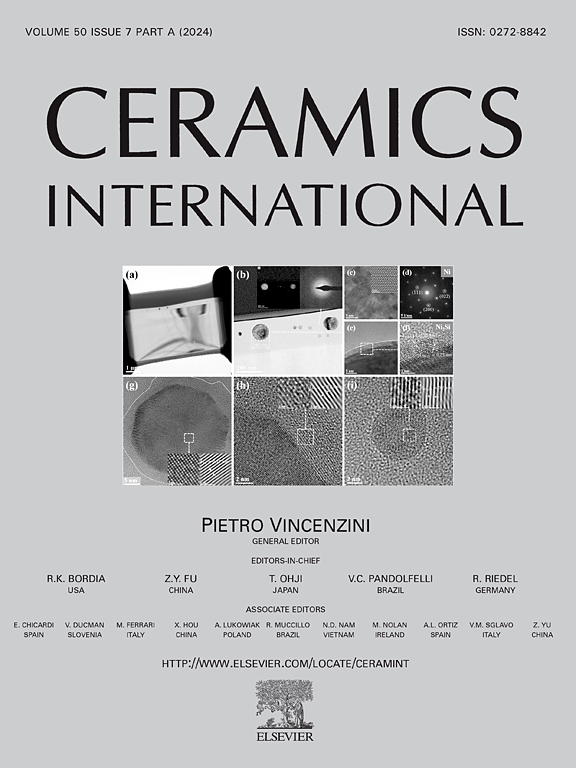Synthesis, characterization and photocatalytic properties of ErBO3 photocatalysts with four morphologies for norfloxacin degradation
IF 5.1
2区 材料科学
Q1 MATERIALS SCIENCE, CERAMICS
引用次数: 0
Abstract
Take advantage of the 4f electron transition of Er ions and two-dimensional nanosheets, four kinds of ErBO3 powders with different morphologies were prepared by hydrothermal method and their photocatalytic degradation performance of Norfloxacin were investigated. XRD and SEM results indicate that all four prepared products are single-phase ErBO3 compounds, exhibiting distinct microstructural morphologies. Among them, the ErBO3(8) flower self-assembled by two-dimensional nanosheets exhibits the highest photocatalytic performance and the degradation rate of norfloxacin can reach 89.6 % after 120 min illumination, and the first-order rate constant is 1.04 × 10−2 min−1. Through the comparative analysis of the four powders’ properties, it was found that ErBO3(8) flower balls had the lowest fluorescence intensity and the highest photocurrent, which indicated that the material exhibits a high efficiency in separating photogenerated carriers. This can primarily be attributed to its unique nanosheet structure, which not only confers a high specific surface area but also significantly increases the concentration of chemisorbed oxygen, thereby effectively suppressing the recombination of photogenerated carriers.
四种形态ErBO3光催化剂的合成、表征及光催化性能研究
利用Er离子的4f电子跃迁和二维纳米片,采用水热法制备了4种不同形貌的ErBO3粉体,并对其光催化降解诺氟沙星的性能进行了研究。XRD和SEM结果表明,制备的四种产物均为单相ErBO3化合物,具有不同的微观结构形态。其中,由二维纳米片自组装的ErBO3(8)花表现出最高的光催化性能,光照120 min后对诺氟沙星的降解率可达89.6%,一级速率常数为1.04 × 10−2 min−1。通过对四种粉末性能的对比分析,发现ErBO3(8)花球具有最低的荧光强度和最高的光电流,表明该材料具有较高的光生载流子分离效率。这主要归因于其独特的纳米片结构,它不仅赋予了高比表面积,而且显著增加了化学吸附氧的浓度,从而有效地抑制了光生载流子的重组。
本文章由计算机程序翻译,如有差异,请以英文原文为准。
求助全文
约1分钟内获得全文
求助全文
来源期刊

Ceramics International
工程技术-材料科学:硅酸盐
CiteScore
9.40
自引率
15.40%
发文量
4558
审稿时长
25 days
期刊介绍:
Ceramics International covers the science of advanced ceramic materials. The journal encourages contributions that demonstrate how an understanding of the basic chemical and physical phenomena may direct materials design and stimulate ideas for new or improved processing techniques, in order to obtain materials with desired structural features and properties.
Ceramics International covers oxide and non-oxide ceramics, functional glasses, glass ceramics, amorphous inorganic non-metallic materials (and their combinations with metal and organic materials), in the form of particulates, dense or porous bodies, thin/thick films and laminated, graded and composite structures. Process related topics such as ceramic-ceramic joints or joining ceramics with dissimilar materials, as well as surface finishing and conditioning are also covered. Besides traditional processing techniques, manufacturing routes of interest include innovative procedures benefiting from externally applied stresses, electromagnetic fields and energetic beams, as well as top-down and self-assembly nanotechnology approaches. In addition, the journal welcomes submissions on bio-inspired and bio-enabled materials designs, experimentally validated multi scale modelling and simulation for materials design, and the use of the most advanced chemical and physical characterization techniques of structure, properties and behaviour.
Technologically relevant low-dimensional systems are a particular focus of Ceramics International. These include 0, 1 and 2-D nanomaterials (also covering CNTs, graphene and related materials, and diamond-like carbons), their nanocomposites, as well as nano-hybrids and hierarchical multifunctional nanostructures that might integrate molecular, biological and electronic components.
 求助内容:
求助内容: 应助结果提醒方式:
应助结果提醒方式:


